Looking for the best piadina recipe? Piadina is a traditional Italian flatbread made with just a few simple ingredients: flour, water, and extra virgin olive oil or lard. This no-yeast dough is quick to prepare and perfect for sandwiches or as a substitute for bread.
Piadina Romagnola comes from Romagna, a region in northern Italy, and is known for its soft texture and lightly toasted surface. Unlike bread, piadina requires no leavening and only a short resting time, making it one of the easiest Italian flatbreads to make at home.

Serve your piadina warm, folded and filled with cheese, cured meats, grilled vegetables, or even sweet spreads. It’s incredibly versatile and pairs beautifully with traditional Italian dishes like grilled meats, salads, or antipasti.
This is the authentic piadina recipe, just like it's made in Italy: not too thin, not too large, slightly crispy on the outside, soft inside, and full of delicate flavor.
Follow my step-by-step piadina recipe to make your own homemade Italian flatbread – fast, easy, and incredibly delicious!
Jump to:
Ingredients
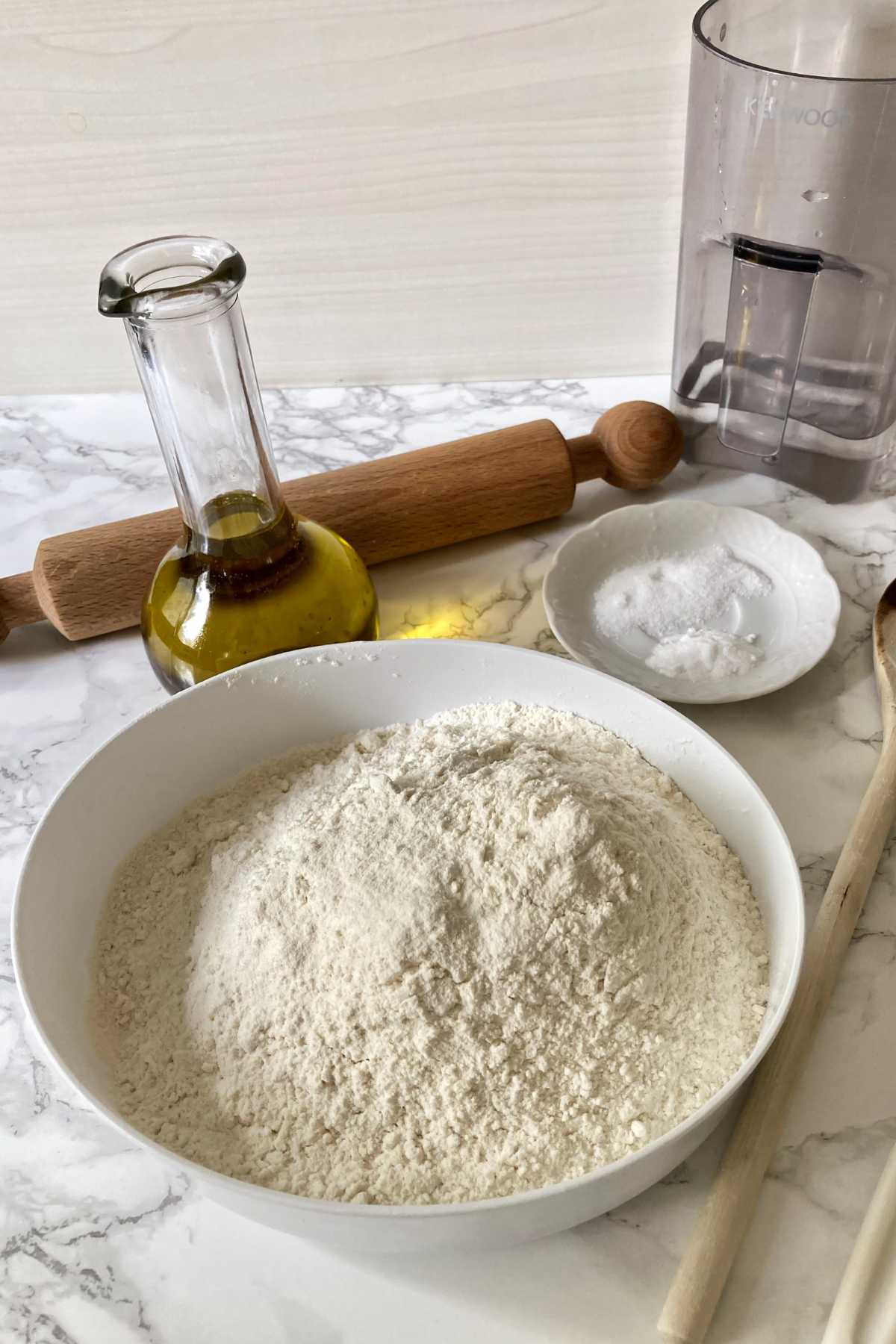
Prep Time: 5 Min | Resting Time: 40 Min | Cook Time: 20 Min | Servings: 6 Piadina of about 20-25 cm (8-10 inch) in diameter
- 500 g (3 ⅓ cups) all purpose flour
- 220 ml (1 cup) water, at room temperature
- 80 ml (about ⅓ cup), extra virgin olive oil or 80 g (about ⅓ cup) lard
- 1 teaspoon salt
- ⅓ teaspoon baking soda
Kitchen Tools and Equipment
To make Piadina Romagliola at home you cannot do without a rolling pin to roll out the dough and obviously a suitable pan to cook them.
ROLLING PIN: There are various types of rolling pin that differ according to the material. Traditionally, wooden or marble rolling pins are perfect, which are also very beautiful as a gift idea for your friends who are passionate about cooking. Even rolling pins of more modern materials like silicone will do. They are very practical and can even be put in the dishwasher.
PAN: Even a pan suitable for cooking Piadina can be an excellent gift idea. The best are completely flat and made of cast iron or non-stick aluminum which are also induction compatible. In ancient times they cooked piadina on the "Testo romagnolo", a terracotta pan that required particular care as it was delicate and easy to break. Actually in Italy grandmothers often still use this kitchen tool. You can find it in Romagna shops that sell handicraft products as souvenirs (have a look here.)
Instructions

Step 1) - To start this piadina recipe, place the flour in a large mixing bowl. Add the baking soda and salt, then stir well to combine. Next, add the fat: either extra virgin olive oil or softened lard, depending on your preference. I used EVO oil for a lighter flavor.

Step 2) - Gradually pour in room-temperature water. Mix the ingredients with a spoon or your hands until a soft, compact dough forms. If the dough feels sticky, add a bit more flour. The piadina dough should be smooth and pliable, but not sticky.

Step 3) - Cover the dough with plastic wrap and let it rest at room temperature for about 30 minutes. This short resting time will help relax the gluten and make the dough easier to roll out.
After resting, divide the dough into 6 equal portions, each weighing around 100 to 110 grams (3.5–3.8 oz).

Step 4) - Roll each portion into a smooth ball using your hands on a lightly floured surface. Cover the dough balls with a clean kitchen towel and let them rest for another 10 minutes.
Using a rolling pin, roll out each ball into a round disc about 4–5 mm thick (roughly 0.20 inch) and 20–25 cm in diameter (8–10 inches).

Step 5) - Don’t worry if they’re not perfectly round—slightly irregular shapes make your homemade piadina look authentic and artisanal.
TIP: While cooking each piadina, keep the others covered with a towel to prevent the dough from drying out.
Cook the Piadina

Step 6) - Heat a non-stick pan or cast-iron skillet over medium heat. Cook one piadina at a time. After about 1 minute, or when bubbles begin to form, flip it. Prick the surface with a fork to prevent large air pockets. Flip it a couple of times during cooking.
Each piadina flatbread takes about 2 minutes per side (4 minutes total). It’s ready when lightly golden with the signature brown spots on the surface.

Step 7) - Your homemade piadina is now ready to enjoy! Stack the cooked piadine on a plate and cover them with a clean towel to keep them warm and soft. Serve them stuffed with cheese, prosciutto, grilled vegetable or simply on their own. Piadina is delicious with everything!
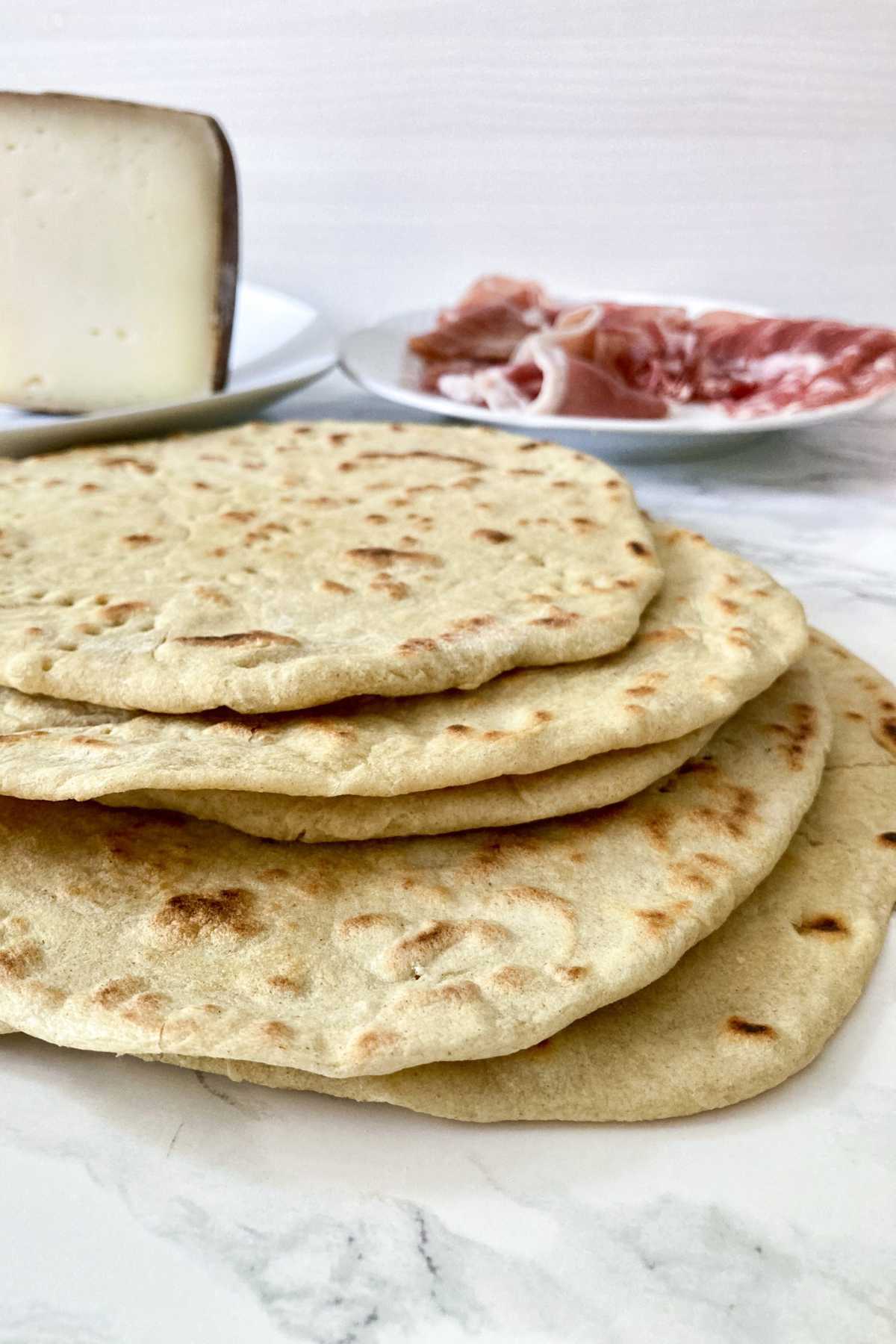
YOU MUST ALSO TRY:
- Bolognese Sauce Recipe
- How to Make Homemade Passatelli
- Lasagna Bolognese Recipe
- Ciambella Romagnola
- Gnocco Fritto | Emilian Fried Puffy Bread
Storage
Once cooked and completely cooled, wrap each piadina in plastic wrap or place them in a sealed food bag. Store at room temperature in a cool, dry place. They’ll stay soft for up to 2 days.
Before serving, reheat your piadina in a hot pan for about 1 minute per side to bring back its freshly made texture.
You can also freeze piadina. Pre-cook each flatbread briefly (about 1 minute per side) then let cool and separate them with parchment paper before freezing. When you're ready to use them, place the frozen piadina straight onto a hot pan without defrosting. In just a few minutes, they’ll be soft and warm, just like freshly made!
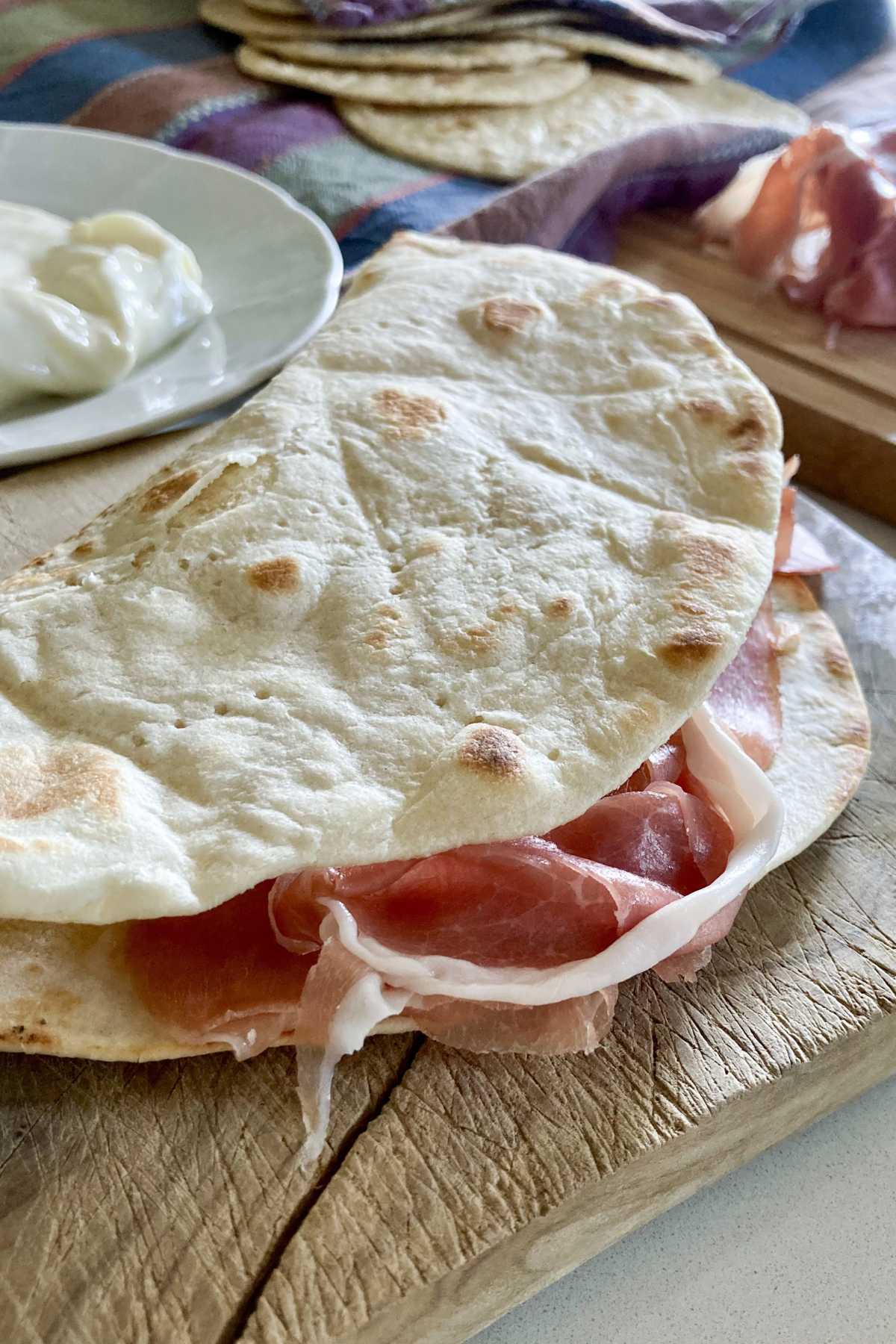
Tips
Want your piadina soft on the inside, slightly crispy on the outside, and never dry like a cracker? Here are a few key tips to get the best results.
Lard or Olive Oil?
Traditionally, authentic piadina was made with lard, especially in rural Romagna where it was widely available and inexpensive. Lard gives piadina a rich, distinctive flavor and is still used in many trattorias and kiosks in the region.
Today, high-quality extra virgin olive oil is often preferred, especially outside Italy. It makes piadina lighter, less caloric, and suitable for vegetarians—without compromising on flavor or texture.
The Right Pan
Always preheat your non-stick or cast-iron pan before cooking piadina. Never turn on the flame after placing the dough in the pan—this ensures even cooking.
Traditionally, piadina was cooked on a Testo Romagnolo, a terracotta pan. Now, thick non-stick or cast-aluminum pans (3–4 mm) are commonly used and give excellent results.
Heat Control is Key
Start by heating the pan over high heat, then reduce to medium before placing the dough. Too low and the piadina dries out, too high and it burns without cooking properly.
Cook for about 2 minutes per side, flipping a couple of times. If bubbles form, gently prick them with a fork to avoid burning and bitterness.
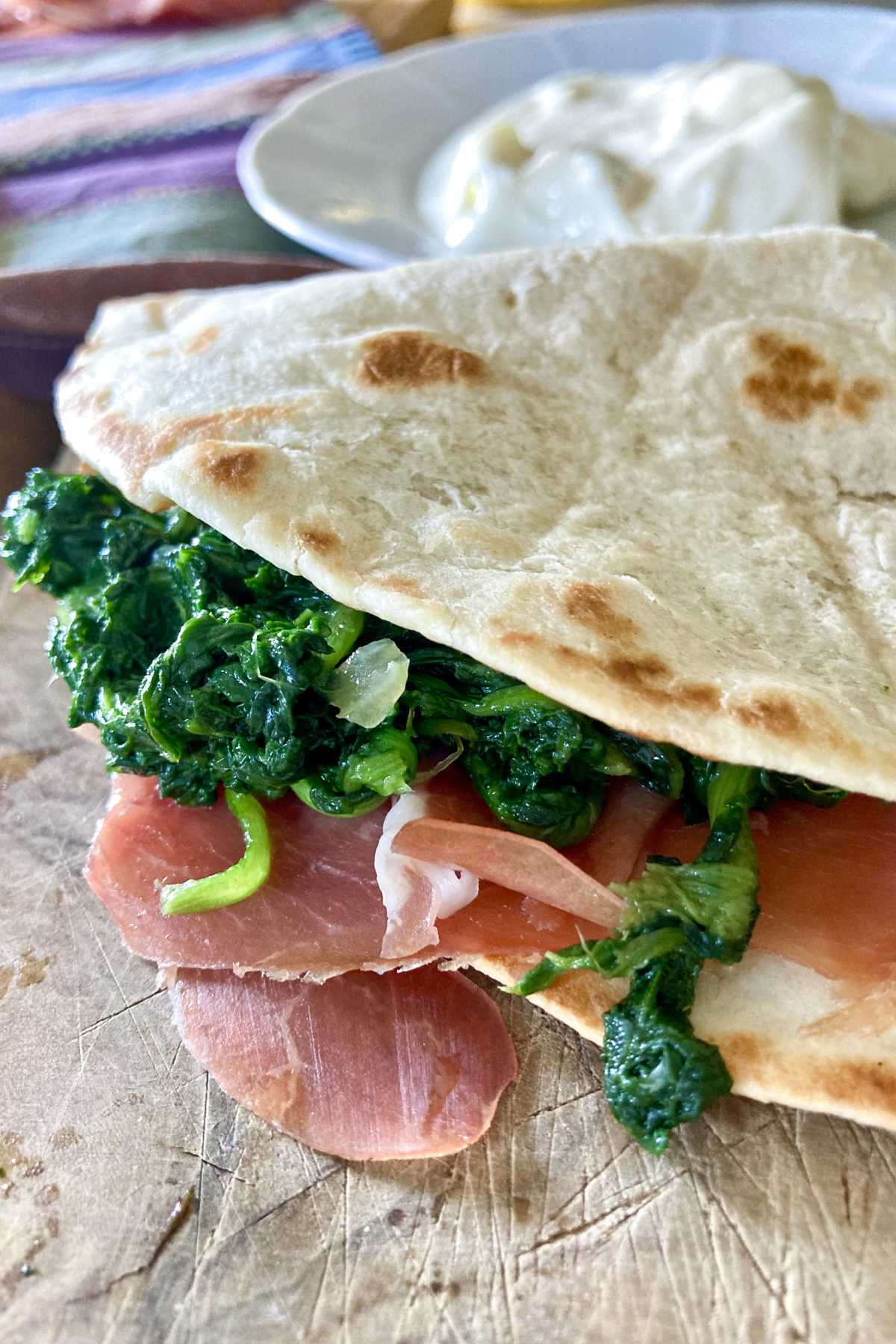
Variations
The piadina recipe can change significantly depending on local traditions and family preferences.
Some versions use milk instead of water to create a softer texture, while others replace the traditional lard with extra virgin olive oil for a lighter and more accessible alternative.
The use of leavening also varies: some recipes include yeast, others use baking soda, and some skip leavening altogether. For a more rustic flavor, wholemeal or less refined flours are sometimes used.
Regional differences also play an important role. The most iconic version is the Piadina Romagnola, typically about 20–25 cm (8–10 inches) in diameter and 5 mm (0.20 inches) thick. In Rimini, the piadina is usually thinner and wider, while in Cesena it tends to be thicker and more bread-like, with less fat. In the Marche region, there's a richer, crumbly variation known as Piadina Sfogliata, made with plenty of lard and sometimes seasoned with a touch of black pepper.
How to Serve Piadina
Piadina is a versatile flatbread that can be filled with various ingredients, both savory and sweet, to suit everyone's preferences.
- Romagna Specialties: In the Romagna region, piadina is often filled with local cheeses and cured meats, such as Parma ham and roast porchetta. A classic combination includes arugula and Stracchino cheese or Squacquerone cheese, which are soft, spreadable Italian cheeses.
- Marche Region Delights: In the Marche area, a traditional piadina filling includes tomato gratin and slices of Pecorino cheese, adding a rich, savory flavor.
- Coastal Flavors: On the Adriatic coast, it’s common to find piadina stuffed with various types of fish, reflecting the region's maritime influence.
- Rimini's Unique Touch: In Rimini, a typical piadina is filled with grilled sardines, radicchio, and onions, creating a unique and flavorful combination.
- Hearty Romagna Fillings: Other beloved fillings in Romagna include potatoes and sausage or chard and sausage, providing a hearty and satisfying meal.
- Summer Favorite: A popular piadina filling during the summer is the Caprese salad, which includes tomato, mozzarella, and basil, offering a refreshing and light option.
- Sweet Treats: Piadina is also enjoyed as a dessert or snack, often filled with homemade fruit jams, chocolate cream, Nutella, or Italian pastry cream and fresh fruit, making it a delightful end to a meal or a sweet afternoon treat.
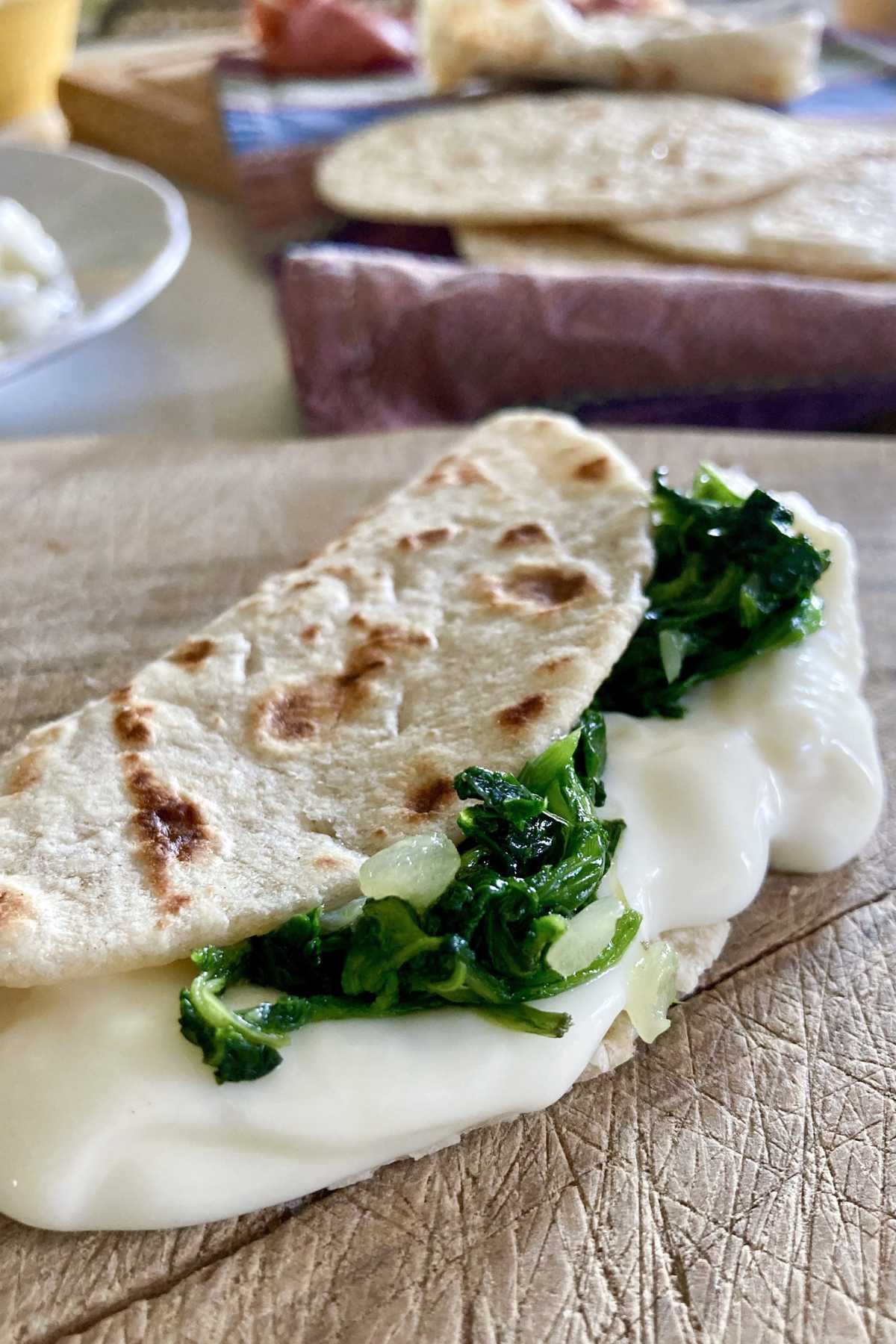
Origins
The origins of piadina date back to ancient times, with the first evidence of unleavened flatbread in Italy going as far back as the Etruscans in the 10th century BC. They cooked simple round breads made with water and flour.
During the Middle Ages, a focaccia similar to piadina became common, especially in the Romagna region, where it was a staple food for poor families during times of famine.
The name "piadina" was officially popularized by the Italian poet Giovanni Pascoli, who called it “the national bread of Romagna.”
From Homemade Tradition to Street Food Icon
For centuries, piadina remained a homemade recipe, lovingly prepared by Romagna’s housewives—known as arzdore—for their families.
Things changed after World War II, during Italy’s economic boom in the 1950s. With tourism growing along the Adriatic coast, the first piadina kiosks appeared along the roads to the beach.
Thanks to these small stands, piadina transformed from a family dish into a beloved Italian street food, recognized far beyond its regional roots.
Today, Piadina Romagnola is protected by the PGI (Protected Geographical Indication) status from the European Union and is celebrated worldwide as a symbol of Italian culinary tradition.

Piadina Romagnola: FAQs
The origins of the word piadina are uncertain. One theory links it to the Greek term platokis, meaning "flatbread." Another possibility is its connection to the Romagna dialect words piè or piès, which mean "to firm up." A third interpretation relates it to piàdena, the wooden board traditionally used to rest and shape baked goods in Emilia-Romagna.
Yes, piadina is a type of Italian flatbread, specifically from the Romagna region. Unlike other flatbreads, piadina is made without yeast, giving it a unique texture: soft, slightly crispy, and perfect for folding or stuffing. It’s thinner and more rustic than traditional bread, and it cooks in just a few minutes.
Absolutely! While traditional piadina is often made with lard for a rich flavor, extra virgin olive oil is a common alternative and works just as well. The result is a lighter version of piadina that still stays soft and tasty, ideal for vegetarian diets or those avoiding animal fats.

Recipe Card

Piadina Romagnola (Italian Flatbread Recipe)
Ingredients
- 500 g all purpose flour - 3 ⅓ cups
- 220 ml water 1 cup, at room temperature
- 80 ml extra virgin olive oil - ~ ⅓ cup, or 80 g (about ⅓ cup) of lard
- 1 teaspoon salt
- ⅓ teaspoon baking soda
Instructions
- Place the flour in a bowl with the baking soda and salt. Mix well. Then add the oil or, if you prefer, the softened lard. We used extra virgin olive oil.
- Add the water at room temperature. Mix everything for a few minutes until you get a soft but compact dough. If the dough sticks to your fingers, add a sprinkling of flour again. Piadina dough must be soft but not sticky.
- Cover the dough with cling film and let it rest at room temperature for about 30 minutes. Then divide the dough into 6 portions of about 100-110 g each (3.5-3.8 oz).
- Work them a little with your hand on the work surface in order to have balls with a smooth surface and let them rest for another 10 minutes covered with a kitchen towel.
- Roll out each ball with the help of a rolling pin, forming a disc with a thickness of ⅘ mm (about 0.20 inch) and a diameter of about 20-25 cm (8-10 inch).
- Cook the Piadina one at a time in a preheated non-stick pan. Turn the Piadina after a minute or when bubbles form. Repeat it twice, pricking it here and there with a fork. The piadina must cook about 2 minutes per side (4 minutes in total). Piadina is ready when it has taken on a slightly golden color and the characteristic small dark spots have appeared on the surface.
- Your homemade Piadina is ready to be stuffed. Arrange them one on top of the other covered with a cloth that will help keep them warm. Bring them to the table stuffed as you like with what you prefer! Piadina is fantastic with everything, even on its own!





Frank Rabusin says
Hi, are you using bread flour for this recipe, or all purpose flour?
Silvana Nava says
All purpose flour is perfect!
Have a nice day
Silvana
GLG says
After reading this I am inspired to make these again to stuff with meats and cheeses etc as sandwiches, vs as an addition to a meat platter. Sure wish we could get the Squacquerone cheese here in the states!
Tim says
Yes, pity! It's in every supermarket here in Veneto, although I use ricotta or stracchino (another soft cheese) in them with the local salami type. I also roll them rather than leave them as half moons that are open
AG says
Beligioioso makes "Crescenza Stracchino," which is quite close.